In recent years, the use of Pampas grass in wedding decor has surged in popularity due to its elegant and versatile nature. This ornamental grass, recognizable by its feathery plumes and tall, graceful stems, offers a unique blend of rustic charm and modern sophistication. Originating from the Pampas region of South America, it is valued for its ability to complement a wide range of wedding themes, from bohemian to contemporary chic. But what makes Pampas grass a standout choice for bouquets and centerpieces? Let's explore its physical characteristics, color varieties, and the cultural significance that has made it a wedding favorite.
Flower Overview
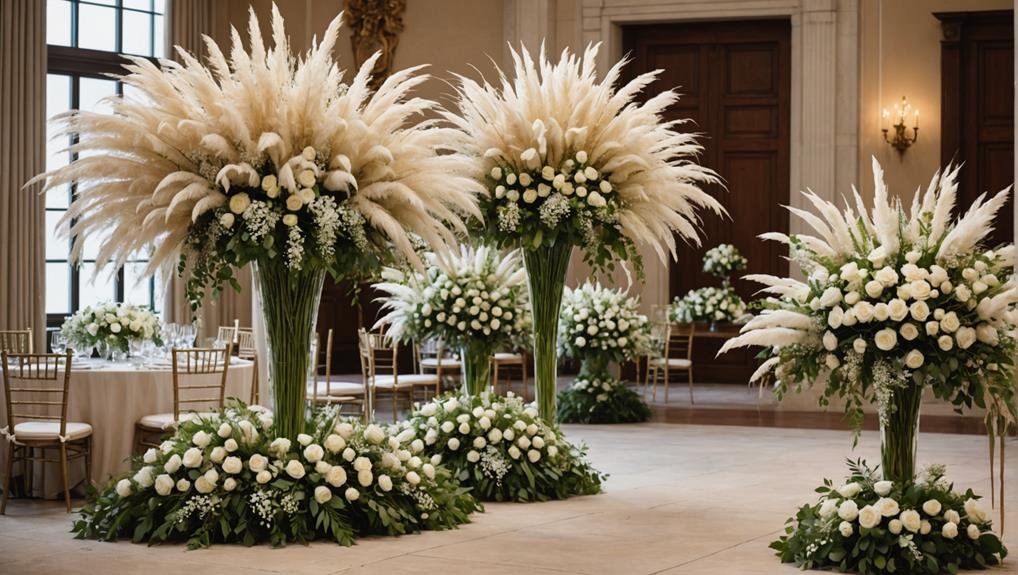
Pampas grass, scientifically known as Cortaderia selloana, is a flowering plant from the Poaceae family, native to the Pampas region of southern South America. This ornamental grass has seen a resurgence in popularity, particularly in the domain of wedding decor. Known for its feathery plumes and tall, elegant stature, pampas grass adds a trendy, boho-chic touch to wedding bouquets and event settings. Its aesthetic appeal has been prominently featured in wedding magazines and styled photo shoots, showcasing its romantic and sophisticated qualities.
The resurgence in the use of pampas grass can be attributed to its versatility and ability to complement various wedding themes. Whether incorporated into bridal bouquets, table centerpieces, or ceremony backdrops, its neutral tones and soft texture create a visually appealing contrast to traditional floral arrangements.
However, it is essential to take into account the highly combustible nature of pampas grass when planning its use in wedding decor. When used in conjunction with candles or in dry environments, it poses a fire risk that must be managed with care.
Physical Description
Characterized by its tall, feathery plumes, Cortaderia selloana typically reaches heights of 10 to 13 feet, creating a dramatic visual impact. Native to southern South America, Pampas Grass is renowned for its striking vertical growth and elegant appearance. The plant features long, slender stalks that culminate in large, plume-like flowers. These plumes generally bloom in late summer, presenting creamy white or subtle pink hues, though the focus here is on their physical form rather than color.
The feathery texture of Pampas Grass makes it an ideal element for creating a romantic and bohemian atmosphere, particularly in wedding settings. Its height and fullness allow it to serve as an eye-catching focal point in various decorative applications.
When dried, the grass retains its structural integrity and visual appeal, making it a versatile option for both fresh and preserved floral arrangements. Often used in centerpieces, aisle decorations, and photo backdrops, Dried Grass versions of Pampas Grass maintain their allure over extended periods, providing lasting beauty and a touch of nature.
Available Colour Varieties
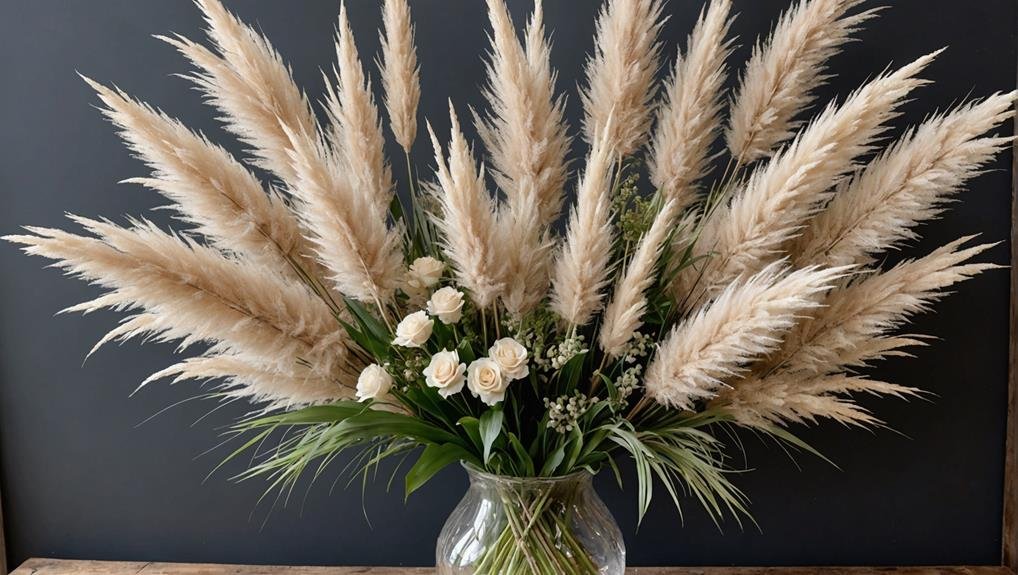
Exploring the available color varieties of Cortaderia selloana reveals a spectrum of hues that can enhance and personalize wedding decor. Naturally, Pampas grass boasts a beautiful beige shade, making it a versatile choice for various wedding themes. This neutral tone works well in rustic, bohemian, and even more refined settings, seamlessly blending into different color palettes.
For couples seeking more customization, Pampas grass can be dyed, allowing for a broader range of color varieties to match specific wedding aesthetics. Soft pink Pampas grass, for example, introduces a romantic and whimsical element to floral arrangements, perfect for creating an enchanting ambiance.
White Pampas grass is another popular option, offering a classic and elegant look that suits traditional and modern wedding designs alike. The purity of white grass adds a touch of sophistication and can be seamlessly integrated into various decor styles. Additionally, Pampas grass can be bleached to achieve a more contemporary and chic appearance, catering to minimalist and avant-garde wedding themes.
These diverse color varieties provide ample opportunities for custom design, allowing couples to tailor their wedding decor to their unique vision and style.
Latin Name and Taxonomy
Cortaderia selloana, commonly known as Pampas Grass, belongs to the Poaceae family and is renowned for its striking, feathery plumes. This flowering plant holds a distinctive place within the taxonomy of grasses due to its unique aesthetic qualities and adaptability. Pampas Grass is categorized under the genus Cortaderia, which encompasses approximately 25 species. The species name 'selloana' honors the German botanist Friedrich Sellow, who contributed significantly to the study of South American flora.
The Poaceae family, also known as Gramineae, is one of the largest plant families, including economically important cereals, bamboos, and grasses. Pampas Grass stands out within this family for its ornamental use, particularly in wedding decor. Its feathery plumes, which can reach lengths of up to 10 feet, add a touch of whimsical elegance and are often favored for their natural, boho appearance.
Pampas Grass is not only admired for its visual appeal but also for its versatility. Its resurgence in popularity, especially in wedding arrangements and event styling, underscores its enduring charm. This plant's adaptability to various environments further cements its status as a sought-after decorative element.
Geographical Origins
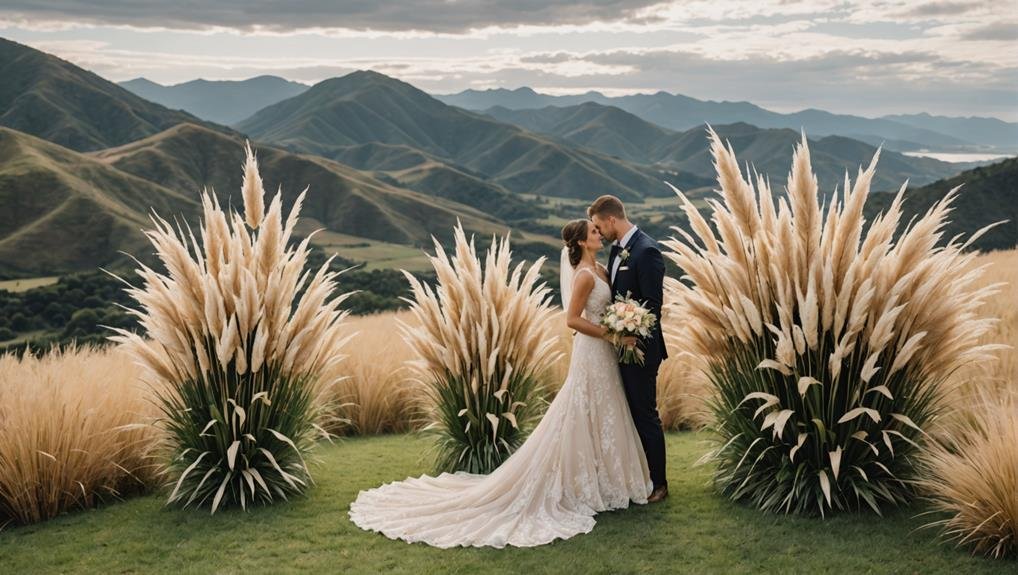
Originating from the vast grasslands of southern South America, Pampas Grass, or Cortaderia selloana, thrives mainly in the Pampas region, which heavily influences its name and ecological characteristics. This region, known for its rich, fertile plains, provides an ideal environment for this resilient grass species.
The geographical origins of Pampas grass contribute significantly to its adaptability and robustness, making it a popular choice for various decorative purposes, including weddings.
Pampas grass, a species in the Poaceae family, has several notable characteristics tied to its South American roots:
- Native Habitat: Found predominantly in the Pampas region, which spans across Argentina, Uruguay, and Brazil, the grass is well-suited to the temperate climate and rich soil of these areas.
- Adaptability: Its ability to thrive in various conditions, from coastal regions to upland areas, speaks to its hardiness and versatility.
- Ecological Impact: In its native habitat, Pampas grass plays an important role in the ecosystem, providing shelter and food for local wildlife.
- Cultural Significance: The resurgence of Pampas grass in modern décor and events, particularly weddings, can be traced back to its origins, where it has long been celebrated for its aesthetic appeal and durability.
Understanding the geographical origins of Pampas grass offers insight into its enduring popularity and practical applications.
Season Availability
Ensuring year-round availability, Pampas grass stands out as a versatile option for weddings and events. This perennial favorite in the wedding industry aligns with the Pampas grass trend by offering a broad spectrum of design possibilities irrespective of the season. Its adaptability allows it to harmonize with various floral arrangements, whether aiming for the cozy, bohemian aesthetic of fall and winter or complementing the vibrant blooms of spring and summer.
Pampas grass can be sourced globally, ensuring its availability regardless of local growing seasons. This global sourcing capability allows event planners and couples to utilize this stylish grass in their designs throughout the year. Available in its natural beige hue or dyed in a range of colors, Pampas grass provides flexibility, fitting seamlessly into diverse wedding themes and color schemes.
Significantly, its season availability means that Pampas grass can add an element of texture and whimsy to floral arrangements, making it a popular choice among modern couples. Whether used as a primary feature or as an accent, its presence enhances the overall aesthetic of wedding décor, maintaining its appeal through changing seasons and trends.
Growing Conditions
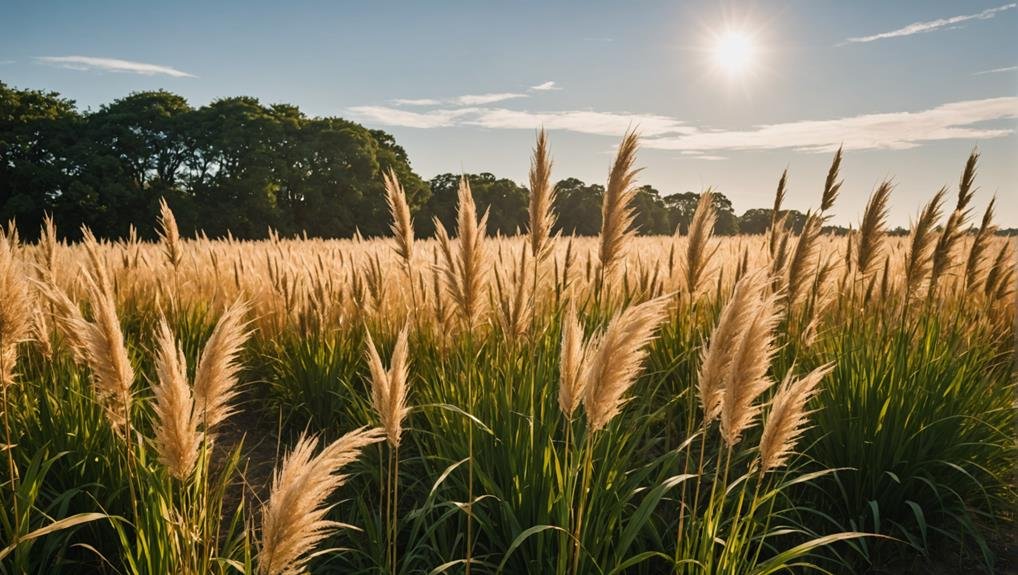
Pampas grass, thriving in USDA zones 7-11, requires full sun or partial shade and well-drained soil to maximize growth. These growing conditions ensure that the plant reaches its full ornamental potential, making it a popular choice for wedding decorations.
To cultivate pampas grass effectively, consider the following key points:
- Spacing: Proper spacing is vital for optimal growth. Each plant should be spaced 6-14 feet apart to allow sufficient room for expansion and airflow, which helps prevent disease and encourages robust flowering.
- Bloom Yield: Achieving a solid bloom yield from seed typically takes 2-3 years. This timeline allows the plant to establish its root system and accumulate the necessary energy for producing its iconic feathery plumes.
- Maintenance: Regular care includes annual pruning to remove dead foliage and promote new growth, clump division to manage size and vigor, and spring fertilization to supply essential nutrients. Monitoring for pests is also recommended to maintain plant health.
- Soil and Watering: Well-drained soil is crucial to prevent root rot. While pampas grass is relatively drought-tolerant once established, young plants require consistent watering to develop a strong root system.
Cultural Significance
In its native South American regions, pampas grass holds deep cultural significance, often being incorporated into traditional ceremonies and celebrations. Particularly in areas like the Pampas, this ornamental grass is a symbol of the natural landscape and heritage. Its feathery plumes are not only aesthetically pleasing but also carry a sense of tradition and continuity.
In many South American cultures, pampas grass is utilized in a variety of ways to mark important life events and festivities. It is common to see it woven into decorations for community gatherings and family celebrations, where it serves as a natural element that connects people to their environment. This practice underscores the cultural importance of pampas grass, reflecting its role in symbolizing growth, abundance, and resilience.
The cultural significance of pampas grass has transcended its native regions, gaining international popularity. Its versatility and neutral tones make it an ideal choice for various decor styles, adding a touch of natural elegance and sophistication to any setting.
In contemporary contexts, pampas grass continues to be celebrated for its beauty and its ability to evoke a sense of connection to nature and tradition.
Typical Use in Weddings
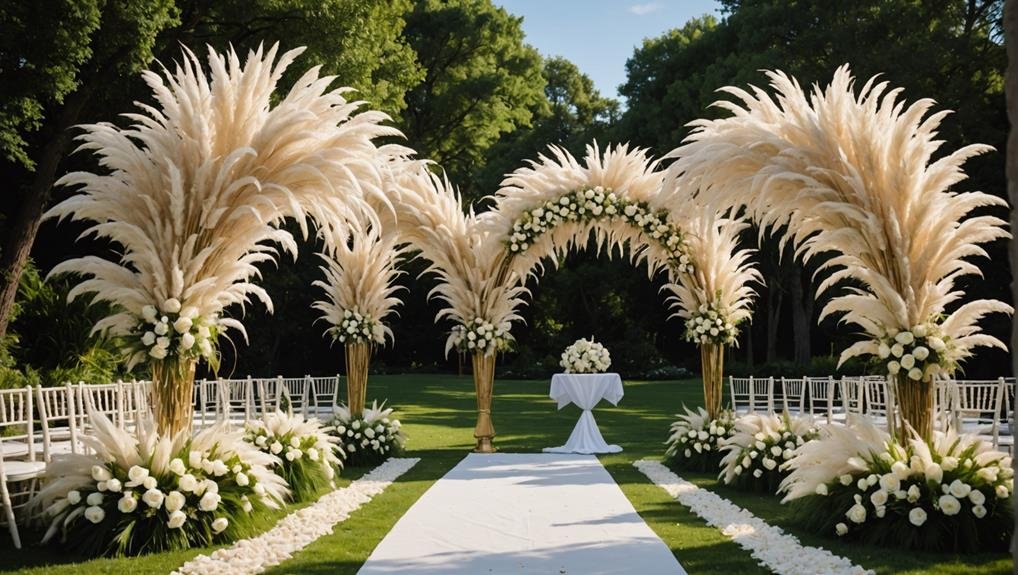
Building on its rich cultural heritage, pampas grass has found a prominent place in modern weddings, where it is celebrated for its versatility and natural elegance. This ornamental grass is frequently used to create striking decor elements that enhance the overall wedding design. Its feathery plumes add a contemporary and bohemian touch, making it a popular choice for various wedding components.
- Bouquets and Boutonnieres:
Pampas grass is often integrated into bridal bouquets and boutonnieres, providing a unique texture and a chic, rustic aesthetic that complements both traditional and modern wedding themes.
- Centerpieces and Decor:
For a stylish and elegant look, pampas grass is utilized in centerpieces and other decor elements. It pairs well with various flowers and greenery, adding height and drama to tablescapes and venue arrangements.
- Signage and Invitations:
Incorporating pampas grass into wedding signage and invitations can enhance the overall design, reflecting the natural and romantic vibe of the event. This subtle touch guarantees that the theme is cohesive from start to finish.
- Photography and Backdrops:
Pampas grass is a favorite for DIY photo booth backdrops and wedding photography setups. Its graceful plumes create a memorable and picturesque scene, perfect for capturing special moments.
Alternative Flower Types
Exploring different flower varieties for wedding decor can unveil a world of creative possibilities beyond traditional floral arrangements. One standout option is pampas grass, which has gained popularity for its unique aesthetic and practical advantages. With its feathery texture and neutral tones, pampas grass offers a versatile choice that complements various decor styles, from bohemian to minimalist themes.
Incorporating pampas grass into wedding flowers can add a whimsical and romantic touch to bouquets, centerpieces, and venue decor. Its natural and airy appearance can create a serene and elegant ambiance, making it a favored choice for couples seeking a unique yet timeless look for their special day.
Additionally, pampas grass is drought-tolerant and long-lasting, which not only makes it a sustainable option but also a cost-effective one, as it can be reused or kept as a memento. Using pampas grass can also provide a sense of continuity and cohesion throughout the wedding decor, seamlessly blending with other floral elements or standing alone as a statement piece.
This alternative flower type offers both aesthetic appeal and practical benefits, making it an excellent choice for modern wedding decor.
